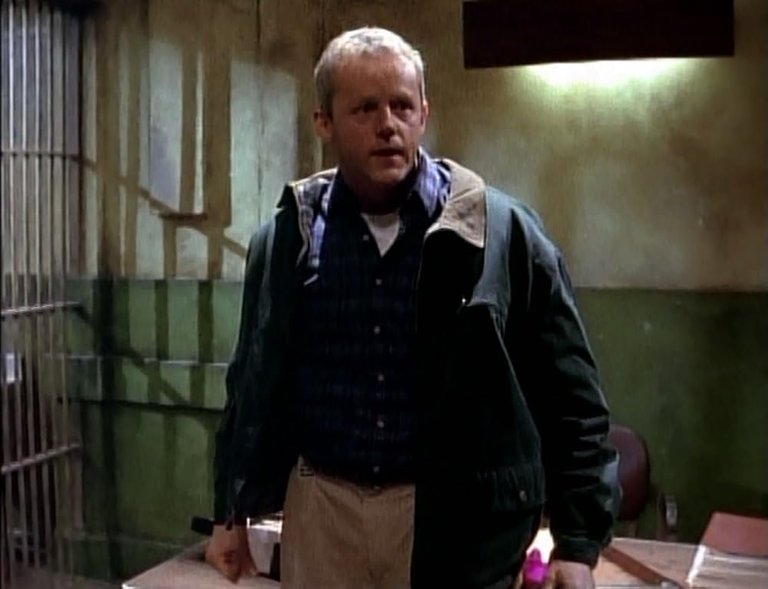
Colors (S03E19)
Airdate: 28 April 1995
Written by: Tom Fontana
Directed by: Peter Medak
Running Time: 48 minutes
By the third season of Homicide: Life on the Street (1994–95), the series had drifted from its origins as a gritty adaptation of David Simon’s 1991 non-fiction book Homicide: A Year on the Killing Streets. While early episodes mirrored the procedural mundanity and moral ambiguity of real-life policing, later instalments increasingly leaned into sensational “Red Ball” cases—high-profile crimes prioritised for their dramatic potential over realism . Yet Colors, directed by Peter Medak and written by Tom Fontana, marked a return to the show’s quasi-docudrama ethos. Loosely inspired by the 1992 shooting of Japanese exchange student Yoshihiro Hattori in Louisiana—a tragedy that galvanised U.S. gun control debates and led to the 1993 Brady Bill—the episode reframes real-world racial tensions and legislative fallout within Baltimore’s fictional landscape.
The real-life Hattori case, in which a teenager was killed after mistakenly approaching a Louisiana home, became a symbol of America’s lethal intersection of xenophobia and lax gun laws. Colors transposes this event to Baltimore, replacing Hattori with Hikmet Gersel (played by Makan Shirafkin), a Turkish exchange student dressed in KISS-inspired makeup for a party. Hikmet’s death—shot on the porch of Jim Bayliss (played by David Morse), a relative of detective Tim Bayliss (played by Kyle Secor)—mirrors the Hattori tragedy’s core: a fatal misunderstanding weaponised by fear. Fontana’s script, however, avoids didacticism. Instead, it layers the incident with ambiguity, probing whether Jim’s actions stemmed from subconscious racism or genuine self-defence. This narrative choice reflects the show’s commitment to complexity, even as it nods to real-world activism spurred by Hattori’s death, such as the Brady Bill’s federal firearm checks.
The episode’s brilliance lies in its Rashomon-style structure, presenting three conflicting testimonies: Jim’s insistence on self-defence, his wife Shannon’s (played by Holly Rudkin) admission of her husband’s frustration with non-English speakers, and Hikmet’s friend Scholtz (played by Johnny Alonso) recounting the victim’s raised hands . Detective Frank Pembleton (played by Andre Braugher), ever the moral provocateur, dissects these inconsistencies, arguing that Jim’s latent bigotry fueled the shooting. Fontana sides with Pembleton’s interpretation but resists closure. The grand jury’s refusal to indict Jim, met with courtroom applause, forces viewers to confront America’s entrenched racial hierarchies. As Pembleton acidly asks Tim: “Would they cheer if the victim were white?”—a question left hauntingly unanswered .
David Morse’s guest performance as Jim elevates the episode. His portrayal oscillates between defensive bluster and fragile introspection, particularly in a late scene where he confesses to Tim: “My dad used a lot of racial slurs… I wonder if that’s why I shot him”. This moment of vulnerability complicates the character, transforming him from a caricature of white anxiety into a tragic product of inherited prejudice.
While Colors is a masterclass in nuanced storytelling, it occasionally succumbs to melodrama. Tim Bayliss’s uncharacteristic outburst—shattering an interrogation room window in protest—feels contrived, a concession to televisual tension at odds with the show’s restrained realism. Similarly, Jim’s violent confrontation with police, which leaves an officer injured without consequence, strains credibility. These flourishes risk undermining the episode’s docudrama gravitas, aligning it more with “Hollywood” excess than the series’ grounded roots.
Yet these missteps are overshadowed by the episode’s thematic ambition. Fontana and Medak juxtapose Baltimore’s decaying urbanity with Stan Bolander’s (played by Ned Beatty) musings on perception: “Nothing is real… Maybe my green is greener than your green” . This existential thread—echoing the show’s broader exploration of subjective truth—frames the shooting as a collision of cultural blindness and institutionalised bias.
Nearly three decades later, “Colors” resonates amid ongoing debates over “Stand Your Ground” laws and racially charged violence. Its refusal to absolve Jim or vilify him entirely mirrors contemporary reckonings with systemic racism—a tension crystallised in Pembleton’s unresolved fury and Tim’s conflicted loyalty . The episode’s power lies not in answers but in its unflinching questions, challenging viewers to interrogate their own “subconscious green”.
While not a flawless classic, Colors epitomises 1990s prestige television: intellectually rigorous, morally ambiguous, and unafraid to indict societal complacency. In an era where crime dramas often prioritise closure over complexity, it remains a testament to Homicide’s singular vision—one that dared to blur the line between fiction and the uncomfortable truths it mirrored.
RATING: 7/10 (+++)
Blog in Croatian https://draxblog.com
Blog in English https://draxreview.wordpress.com/
InLeo blog https://inleo.io/@drax.leo
Hiveonboard: https://hiveonboard.com?ref=drax
Rising Star game: https://www.risingstargame.com?referrer=drax
1Inch: https://1inch.exchange/#/r/0x83823d8CCB74F828148258BB4457642124b1328e
BTC donations: 1EWxiMiP6iiG9rger3NuUSd6HByaxQWafG
ETH donations: 0xB305F144323b99e6f8b1d66f5D7DE78B498C32A7
BCH donations: qpvxw0jax79lhmvlgcldkzpqanf03r9cjv8y6gtmk9